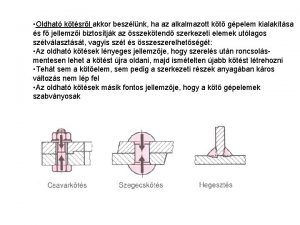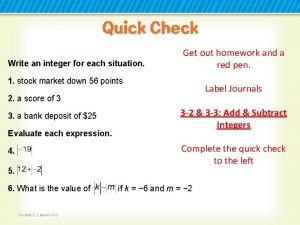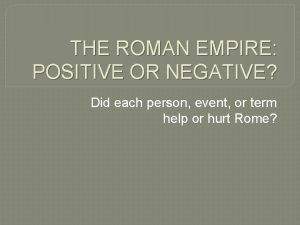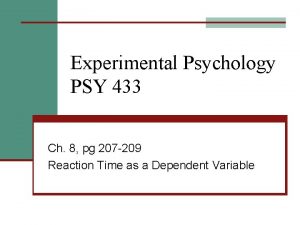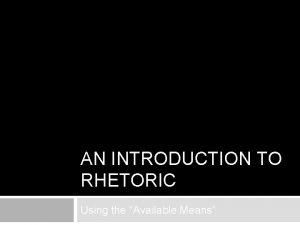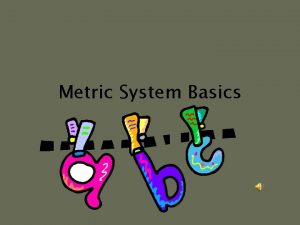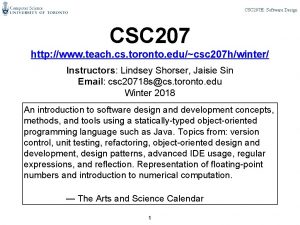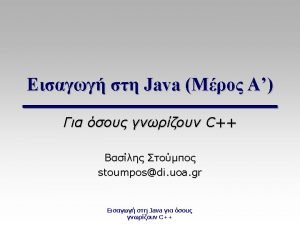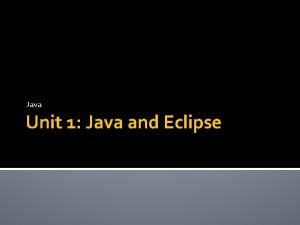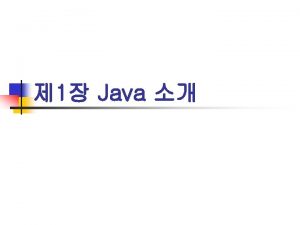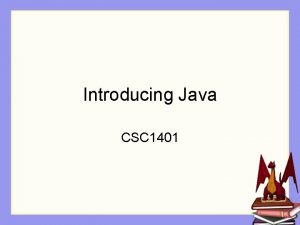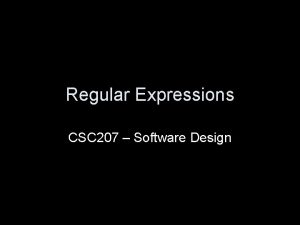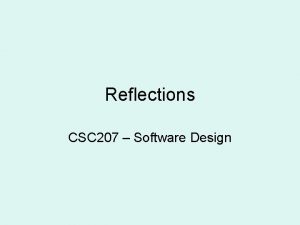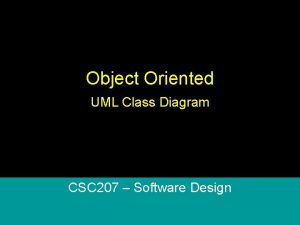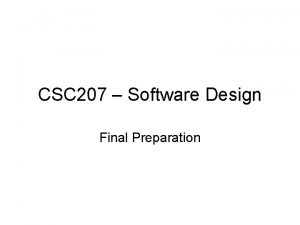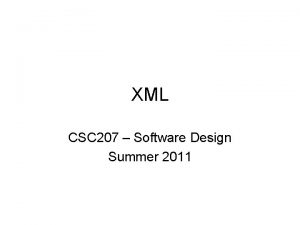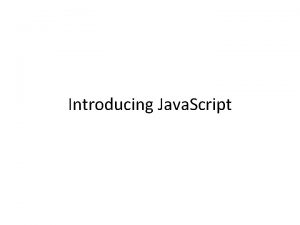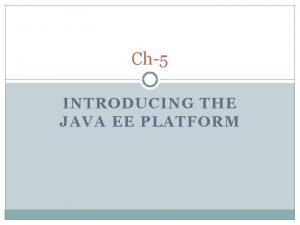Introducing Java csc 207 Fall fall 2012 CSC

























































- Slides: 57

Introducing Java csc 207, Fall fall 2012 CSC 207 2015 Diane Horton University of Toronto

Reference Material on Java See: • the Lectures page for readings • the Software page for a larger list of references This reference is particularly useful: http: //docs. oracle. com/javase/tutorial/java/TOC. html

Running Programs What is a program? What does it mean to “run” a program? To run a program, it must be translated from the high-level programming language it is written in to a low-level machine language whose instructions can be executed. Roughly, two flavours of translation: • Interpretation • Compilation

Interpreted vs. Compiled Interpreted: • e. g. , Python • Translate and execute one statement at a time Compiled: • e. g. , C • Translate the entire program (once), then execute (any number of times) Hybrid: • e. g. , Java • Translate to something intermediate (in Java, bytecode)

Compiling Java You need to compile, then run (as described above). If using command line, you need to do this manually. First, compile using “javac”: dianeh@laptop$ javac Hello. World. java This produces file “Hello. Word. class”: dianeh@laptop$ ls Hello. World. class Hello. World. java Now, run the program using “java”: dianeh@laptop$ java Hello. World Hello world! Most modern IDEs offer to do this for you (Eclipse does). But you should know what’s happening under the hood!

Defining Classes in Java CSC 207 Fall 2015

Instance Variables public class Circle { private String radius; } radius is an instance variable. Each object/instance of the Circle class has its own radius variable.

Constructors A constructor has: • the same name as the class • no return type (not even void) A class can have multiple constructors, as long as their signatures are different. If you define no constructors, the compiler supplies one with no parameters and no body. If you define any constructor for a class, the compiler will no longer supply the default constructor.

this is an instance variable that you get without declaring it. It’s like self in Python. Its value is the address of the object whose method has been called.

Defining methods • A method must have a return type declared. Use void if nothing is returned. • The form of a return statement: return expression; If the expression is omitted or if the end of the method is reached without executing a return statement, nothing is returned. • Must specify the accessibility. For now: public - callable from anywhere private - callable only from this class • Variables declared in a method are local to that method.

Parameters When passing an argument to a method, you pass what’s in the variable’s box: • For class types, you are passing a reference. (Like in Python. ) • For primitive types, you are passing a value. (Python can’t do anything like this. ) This has important implications! You must be aware of whether you are passing a primitive or object.

Instance Variables and Accessibility If an instance variable is private, how can client code use it? Why not make everything public — so much easier!

Encapsulation Think of your class as providing an abstraction, or a service. • We provide access to information through a welldefined interface: the public methods of the class. • We hide the implementation details. What is the advantage of this “encapsulation”?

Conventions Make all non-final instance variables either: • private: accessible only within the class, or • protected: accessible only within the package. When desired, give outside access using “getter” and “setter” methods. [A final variable cannot change value; it is a constant. ]

Access Modifiers Classes can be declared public or package-private. Members of classes can be declared public, protected, packageprotected, or private. Modifier Packag Subcla Class World e ss public Yes Yes protected Yes Yes No default (package private) Yes No No private Yes No No No

Inheritance in Java CSC 207 Fall 2015

Inheritance hierarchy All classes form a tree called the inheritance hierarchy, with Object at the root. Class Object does not have a parent. All other Java classes have one parent. If a class has no parent declared, it is a child of class Object. A parent class can have multiple child classes. Class Object guarantees that every class inherits methods to. String, equals, and others.

Inheritance allows one class to inherit the data and methods of another class. In a subclass, super refers to the part of the object defined by the parent class. • Use super. «attribute» to refer to an attribute (data member or method) in the parent class. • Use super( «arguments» ) to call a constructor defined in the parent class.

Constructors and inheritance If the first step of a constructor is super( «arguments» ), the appropriate constructor in the parent class is called. • Otherwise, the no-argument constructor in the parent is called. Net effect on order if, say, A is parent of B is parent of C? Which constructor should do what? Good practise: • Initialize your own variables. • Count on ancestors to take care of theirs.

Multi-part objects Suppose class Child extends class Parent. An instance of Child has • a Child part, with all the data members and methods of Child • a Parent part, with all the data members and methods of Parent • a Grandparent part, … etc. , all the way up to Object. An instance of Child can be used anywhere that a Parent is legal. • But not the other way around.

Name lookup A subclass can reuse a name already used for an inherited data member or method. Example: class Person could have a data member motto and so could class Student. Or they could both have a method with the signature sing(). When we construct x = new Student(); the object has a Student part and a Person part. If we say x. motto or x. sing(), we need to know which one we’ll get! In other words, we need to know how Java will look up the name motto or sing inside a Student object.

Name lookup rules For a method call: expression. method(arguments) • Java looks for method in the most specific, or bottommost part of the object referred to by expression. • If it’s not defined there, Java looks “upward” until it’s found (else it’s an error). For a reference to an instance variable: expression. variable • Java determines the type of expression, and looks in that box. • If it’s not defined there, Java looks “upward” until it’s found (else it’s an error).

Shadowing and Overriding Suppose class A and its subclass AChild each have an instance variable x and an instance method m. A’s m is overridden by Achild’s m. • This is often a good idea. We often want to specialize behaviour in a subclass. A’s x is shadowed by Achild’s x. • This is confusing and rarely a good idea. If a method must not be overridden in a descendant, declare it final.

Casting for the compiler If we could run this code, Java would find the char. At method in o, since it refers to a String object: Object o = new String(“hello”); char c = o. char. At(1); But the code won’t compile because the compiler cannot be sure it will find the char. At method in o. Remember: the compiler doesn’t run the code. It can only look at the type of o. So we need to cast o as a String: char c = ((String) o). char. At(1);

Javadoc Like a Python docstring, but more structured, and placed above the method. /** * Replace a square wheel of diagonal diag with a round wheel of * diameter diam. If either dimension is negative, use a wooden tire. * @param diag Size of the square wheel. * @param diam Size of the round wheel. * @throws Pi. Exception If pi is not 22/7 today. */ public void square. To. Round(double diag, double diam) {. . . } Javadoc is written for classes, member variables, and member methods. This is where the Java API documentation comes from! In Eclipse: Project → Generate Javadoc

Java naming conventions The Java Language Specification recommends these conventions Generally: Use camel. Case not pothole_case. Class name: A noun phrase starting with a capital. Method name: A verb phrase starting with lower case. Instance variable: A noun phrase starting with lower case. Local variable or parameter: ditto, but acronyms and abbreviations are more okay. Constant: all uppercase, pothole. E. g. , MAX_ENROLMENT

Direct initialization of instance variables You can initialize instance variables inside constructor(s). An alternative: initialize in the same statement where they are declared. Limitations: Can only refer to variables that have been initialized in previous lines. Can only use a single expression to compute the initial value.

What happens when 1. Allocate memory for the new object. 2. Initialize the instance variables to their default values: 0 for ints, false for booleans, etc. , and null for class types. 3. Call the appropriate constructor in the parent class. The one called on the first line, if the first line is super(arguments), else the no-arg constructor. 4. Execute any direct initializations in the order in which they occur. 5. Execute the rest of the constructor.

Abstract classes and interfaces A class may define methods without giving a body. In that case: Each of those methods must be declared abstract. The class must be declared abstract too. The class can’t be instantiated. A child class may implement some or all of the inherited abstract methods. If not all, it must be declared abstract. If all, it’s not abstract and so can be instantiated. If a class is completely abstract, we may choose instead to declare it to be an interface.

Interfaces An interface is (usually) a class with no implementation. It has just the method signatures and return types. It guarantees capabilities. Example: java. util. List "To be a List, here are the methods you must support. ” A class can be declared to implement an interface. This means it defines a body for every method. A class can implement 0, 1 or many interfaces, but a class may extend only 0 or 1 classes. An interface may extend another interface.

Generics: naming conventions The Java Language Specification recommends these conventions for the names of type variables: very short, preferably a single character but evocative all uppercase to distinguish them from class and interface names Specific suggestions: Maps: K, V Exceptions: X Nothing particular: T (or S, T, U or T 1, T 2, T 3 for several)

Intro to Exceptions

What are exceptions? Exceptions report exceptional conditions: unusual, strange, disturbing. These conditions deserve exceptional treatment: not the usual go-to-the-next-step, plod-onwards approach. Therefore, understanding exceptions requires thinking about a different model of program execution.

Exceptions in Java To “throw an exception”: throw Throwable; To “catch an exception” and deal with it: try { statements } catch (Throwable parameter) { try. // The catch belongs to the statements } To say you aren’t going to deal with exceptions (or may throw your own):

Analogy throw: I'm in trouble, so I throw a rock through a window, with a message tied to it. try: Someone in the following block of code might throw rocks of various kinds. All you catchers line up ready for them. catch: If a rock of my kind comes by, I'll catch it and deal with it. throws: I’m warning you: if there’s trouble, I may throw a rock.

Examples Dealing with exceptions: • You will call many methods that can generate exceptions if something goes wrong. E. g. , I/O methods. • Example. . . • You can try-catch, or “pass it on” Throwing your own exceptions: • Example. . .

Why use exceptions? Less programmer time spent on handling errors Cleaner program structure: isolates exceptional situations rather than sprinkling them through the code Separation of concerns: Pay local attention to the algorithm being implemented and global attention to errors that are raised

(Bad) Example int i = 0; int sum = 0; try { while (true) { sum += i++; if (i >= 10) { // we’re done throw new Exception("i at limit"); } } } catch (Exception e) { System. out. println("sum to 10 = " + sum); }

Why was that code bad? The situation that the exception reports is not exceptional. It’s obvious that i will eventually be 10. It's expected. Unlike Python, exceptions are reserved for exceptional situations. It's uncharacteristic. Real uses of exceptions aren't local. throw and catch aren't generally in the same block of code.

We can have cascading catches Much like an if with a series of else if clauses, a try can have a series of catch clauses. After the last catch clause, you can have a clause: finally {. . . } But finally is not like a last else on an if statement: The finally clause is always executed, whether an exception was thrown or not, and whether or not the thrown exception was caught. Example of a good use for this: close open files as a clean-up step.

An example of multiple catches Suppose Ex. Sup is the parent of Ex. Sub. A and Ex. Sub. B. try {. . . } catch (Ex. Sub. A e) { // We do this if an Ex. Sub. A is thrown. } catch (Ex. Sup e) { // We do this if any Ex. Sup that's not an Ex. Sub. A is thrown. } catch (Ex. Sub. B e) { // We never do this, even if an Ex. Sub. B is thrown. } finally { // We always do this, even if no exception is thrown.

Exceptions, Part 2

Recap If you call code that may throw an exception, you have two choices. When you declare that a method “throws” something, you are reserving the right to do so, not guaranteeing that you will. Exceptions don’t follow the normal control flow. Some guidelines on using exceptions well: Use exceptions for exceptional circumstances. Throwing and catching should not be in the same method. “Throw low, catch high”.

Where Exception fits in Throwable Error Exception Assertion. Error. . . Out. Of. Memory. Error IOException. . . Runtime. Exception Arithmetic. Exception. . . Class. Cast. Exception

“Throwable” has useful methods Constructors: Throwable(), Throwable(String message) Other useful methods: get. Message() print. Stack. Trace() get. Stack. Trace() You can also record (and look up) within a Throwable it’s “cause”: another Throwable that caused it to be thrown. Through this, you can record (and look up) a chain of exceptions.

You don’t have to handle Errors or Runtime. Exceptions Error: “Indicates serious problems that a reasonable application should not try to catch. ” Do not have to handle these errors because they “are abnormal conditions that should never occur. ” Runtime. Exception: These are called “unchecked” because you do not have to handle them. A good thing, because so many methods throw them it would be cumbersome to check them all.

Some things not to catch Don’t catch Error: You can’t be expected to handle these. Don’t catch Throwable or Exception: Catch something more specific. (You can certainly do so when you’re experimenting with exceptions. Just don’t do it in real code without a good reason. )

What should you throw? You can throw an instance of Throwable or any subclass of it (whether an already defined subclass, or a subclass you define). Don’t throw an instance of Error or any subclass of it: These are for unrecoverable circumstances. Don’t throw an instance of Exception: Throw something more specific. It’s okay to throw instances of: specific subclasses of Exception that are already defined, e. g. , Unsupported. Operation. Exception

Extending Exception: version 1 Example: a method m() that throws your own exception My. Exception, a subclass of Exception: class My. Exception extends Exception {. . . } class My. Class { public void m() throws My. Exception {. . . if (. . . ) throw new My. Exception("oops!"); . . . } }

Extending Exception: version 2 Example: a method m() that throws your own exception My. Exception, a subclass of Exception: class My. Class { public static class My. Exception extends Exception {. . . } public void m() throws My. Exception {. . . if (. . . ) throw new My. Exception("oops!"); . . . } }

Aside: classes inside other classes You can define a class inside another class. There are two kinds. Static nested classes use the static keyword. (It can only be used with classes that are nested. ) Cannot access any other members of the enclosing class. Inner classes do not use the static keyword. Can access all members of the enclosing class (even private ones). Nested classes increase encapsulation. They make sense if you won’t need to use the class outside its

Documenting Exceptions /** * Return the mness of this object up to mlimit. * @param mlimit The max mity to be checked. * @return int The mness up to mlimit. * @throws My. Exception If the local alphabet has no m. */ public void m(int mlimit) throws My. Exception {. . . if (. . . ) throw new My. Exception ("oops!"); . . . } You need both: the Javadoc comment is for human readers, and the throws is for the compiler. Both the reader and the compiler are checking that caller and

Extend Exception or Runtime. Exception? Recall that Runtime. Exceptions are not checked. Example: class My. Class { public static class My. Exception extends Runtime. Exception {. . . } public void m() /* No "throws”, yet it compiles! */ {. . . if (. . . ) throw new My. Exception("oops!"); . . . } } How do you choose whether to extend Exception or Runtime. Exception? Perhaps you should always extend Exception to benefit from the compiler's exception checking?

What does the Java API say? Exception: “The class Exception and its subclasses are a form of Throwable that indicates conditions that a reasonable application might want to catch. ” Runtime. Exception (not checked): “Runtime. Exception is the superclass of those exceptions that can be thrown during the normal operation of the Java Virtual Machine. ” Runtime. Exception examples: Arithmetic. Exception, Index. Out. Of. Bounds. Exception, No. Such. Element. Exception, Null. Pointer. Exception non-Runtime. Exception (checked): non-Runtime. Exception examples:

What does the Java Language Specification say? “The runtime exception classes (Runtime. Exception and its subclasses) are exempted from compile-time checking because, in the judgment of the designers of the Java programming language, having to declare such exceptions would not aid significantly in establishing the correctness of programs. . The information available to a compiler, and the level of analysis the compiler performs, are usually not sufficient to establish that such run-time exceptions cannot occur, even though this may be obvious to the programmer. Requiring such exception classes to be declared would simply be an irritation to programmers. ” Reference: http: //docs. oracle. com/javase/specs/jls/se 5. 0/html/eptions.

Example Imagine code that implements a circular linked list. Suppose that, by construction, this structure can never involve null references. The programmer can then be certain that a Null. Pointer. Exception cannot occur. But it would be difficult for a compiler to prove it. The theorem-proving technology that is needed to establish such global properties of data structures is developing, though. Wait 10 years. : -) Interested? Take CSC 324 (programming languages) and CSC 488 (compilers). So if Null. Pointer. Exception were checked, the programmer would

Good advice from Joshua Bloch "Use checked exceptions for conditions from which the caller can reasonably be expected to recover. " "Use run-time exceptions to indicate programming errors. The great majority of run-time exceptions indicate precondition violations. " I. e. , if the programmer could have predicted the exception, don’t make it checked. Example: Suppose method get. Item(int i) returns an item at a particular index in a collection and requires that i be in some valid range. The programmer can check that before they call o. get. Item(x). So sending an invalid index should not cause a checked exception to be thrown.
 Csc 207
Csc 207 Iso/tc 207
Iso/tc 207 Article 207 tfeu
Article 207 tfeu Adil balghonaim
Adil balghonaim Menetmángorlás
Menetmángorlás Write an instruction for each situation
Write an instruction for each situation As a result of 207 years of pax romana, the roman empire
As a result of 207 years of pax romana, the roman empire Pg 207
Pg 207 Oae207
Oae207 Apche web server
Apche web server Oecd 207
Oecd 207 Ae 207
Ae 207 Acc 207
Acc 207 Visual studio 2012 java
Visual studio 2012 java Phrase signal
Phrase signal Introducing phonology answer key
Introducing phonology answer key Introducing james joyce
Introducing james joyce Explaining a quote sentence starters
Explaining a quote sentence starters Phrases to introduce the counterclaim
Phrases to introduce the counterclaim Introducing yourself for a job
Introducing yourself for a job Talk boost tracker
Talk boost tracker Ma
Ma Mga halimbawa ng tulang diyamante
Mga halimbawa ng tulang diyamante Introduction of human digestive system
Introduction of human digestive system Background of kfc company
Background of kfc company Integers essential questions
Integers essential questions Introducing internet
Introducing internet Sentence starters for embedding quotes
Sentence starters for embedding quotes Introducing new market offerings
Introducing new market offerings As he himself puts it the art of quoting summary
As he himself puts it the art of quoting summary Introducing windows 7
Introducing windows 7 Khdmdcm conversion
Khdmdcm conversion How to write a good short bio
How to write a good short bio Relocation diffusion definition
Relocation diffusion definition Definition of blood relation
Definition of blood relation Introducing the odyssey
Introducing the odyssey Letter exchange student
Letter exchange student Introducing broker vs carrying broker
Introducing broker vs carrying broker Introducing family members in french
Introducing family members in french Safe relentless improvement
Safe relentless improvement Definition of politics
Definition of politics Introducing flex pods
Introducing flex pods Greeting and leave
Greeting and leave Introducing neeta anil said
Introducing neeta anil said An introduction to rhetoric using the available means
An introduction to rhetoric using the available means Templates for introducing quotations
Templates for introducing quotations Templates for introducing quotations
Templates for introducing quotations What's the metric system
What's the metric system Introduce yourself
Introduce yourself Introducing a quote
Introducing a quote Operational definition of affection
Operational definition of affection Adobe illustrator 11.0
Adobe illustrator 11.0 The purpose of introducing weakened microbes
The purpose of introducing weakened microbes Introducing and naming new products and brand extensions
Introducing and naming new products and brand extensions Introducing and naming new products and brand extensions
Introducing and naming new products and brand extensions Ariel trust
Ariel trust Import java util scanner
Import java util scanner Import java.util.*
Import java.util.*




